N7-methyladenosine-induced SLC7A7 serves as a prognostic biomarker in pan-cancer and promotes CRC progression in colorectal cancer
- PMID: 39730571
- PMCID: PMC11680768
- DOI: 10.1038/s41598-024-80885-2
N7-methyladenosine-induced SLC7A7 serves as a prognostic biomarker in pan-cancer and promotes CRC progression in colorectal cancer
Abstract
Solute transport family 7A member 7 (SLC7A7) mutations contribute to lysinuric protein intolerance (LPI), which is the mechanism of action that has been extensively studied. In colorectal cancer (CRC), SLC7A7 appears to play a role, but the features and mechanisms are not yet well understood. Survival was analyzed using the Kaplan-Meier analysis. Enrichment analysis was performed to characterize, immune infiltration, methylation, genetic instability, and crucial pathways of SLC7A7. Afterward, functional experiments were conducted in vitro to investigate how SLC7A7 affects tumor metastasis. Mechanistically, quantitative real-time PCR (qRT-PCR), western blot (WB), and methylated RNA immunoprecipitation (me-RIP) were carried out to confirm the methylation modification of SLC7A7 and related functions. High levels of expression of SLC7A7 are predictive of a worse prognosis for CRC patients. Enrichment analysis showed that SLC7A7 was significantly enriched during EMT and could be enriched in the Wnt/β-catenin signaling pathway, immune infiltration analysis of pan-cancer showed that SLC7A7 was significantly enriched in macrophages, and methylation analysis showed that SLC7A7 methylation modification affected the prognosis of specific cancers. SLC7A7 was indicated to promote the migration and invasion of CRC cells in in vitro functional experiments. Mechanistically, SLC7A7 was observed to potentially interact with the Wnt/β-catenin signaling pathway, possibly by influencing adenomatous polyposis coli (APC) expression. Furthermore, we identified that SLC7A7 undergoes N7-methylguanosine (m7G) modification, which may regulate SLC7A7 mRNA stability, with Quaking (QKI) potentially playing a role in this process by recognizing the m7G modification. Our results indicate that SLC7A7 may promote CRC metastasis through the SLC7A7/APC/Wnt/β-catenin signaling pathway. Moreover, m7G modification might be involved in regulating SLC7A7 mRNA stability, highlighting a novel layer of regulation.
Keywords: Colorectal cancer; Invasion; Migration; SLC7A7; m7g modification.
© 2024. The Author(s).
Conflict of interest statement
Declarations. Competing interests: The authors declare no competing interests. Ethical approval: Ethical approval was confirmed by the Ethics Committee of the First Affiliated Hospital of Zhengzhou University (2019-KY-423). All mouse procedures were approved by the Institutional Animal Care and Use Committee of Zhengzhou University.
Figures
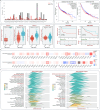
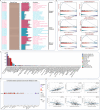
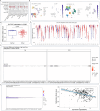
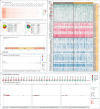
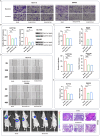
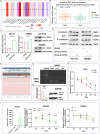
Similar articles
-
ITGB5 is a prognostic factor in colorectal cancer and promotes cancer progression and metastasis through the Wnt signaling pathway.Sci Rep. 2025 Mar 18;15(1):9225. doi: 10.1038/s41598-025-93081-7. Sci Rep. 2025. PMID: 40097546 Free PMC article.
-
MEX3A promotes colorectal cancer migration, invasion and EMT via regulating the Wnt/β-catenin signaling pathway.J Cancer Res Clin Oncol. 2024 Jun 25;150(6):319. doi: 10.1007/s00432-024-05845-9. J Cancer Res Clin Oncol. 2024. PMID: 38914858 Free PMC article.
-
METTL14-mediated N6-methyladenosine modification of SOX4 mRNA inhibits tumor metastasis in colorectal cancer.Mol Cancer. 2020 Jun 17;19(1):106. doi: 10.1186/s12943-020-01220-7. Mol Cancer. 2020. PMID: 32552762 Free PMC article.
-
N7-methylguanosine modification in cancers: from mechanisms to therapeutic potential.J Hematol Oncol. 2025 Jan 29;18(1):12. doi: 10.1186/s13045-025-01665-7. J Hematol Oncol. 2025. PMID: 39881381 Free PMC article. Review.
-
Functions of METTL1/WDR4 and QKI as m7G modification - related enzymes in digestive diseases.Front Pharmacol. 2025 Jan 9;15:1491763. doi: 10.3389/fphar.2024.1491763. eCollection 2024. Front Pharmacol. 2025. PMID: 39850560 Free PMC article. Review.
References
-
- Punt, C. J., Koopman, M. & Vermeulen, L. From tumour heterogeneity to advances in precision treatment of colorectal cancer. Nat. Rev. Clin. Oncol.14(4), 235–246 (2017). - PubMed
-
- Dekker, E. & Rex, D. K. Advances in CRC prevention: screening and surveillance. Gastroenterology.154(7), 1970–1984 (2018). - PubMed
MeSH terms
Substances
Grants and funding
LinkOut - more resources
Full Text Sources
Medical
Miscellaneous

